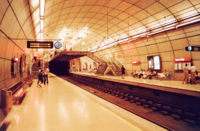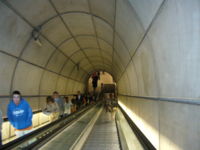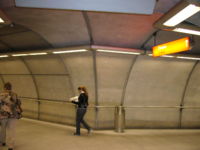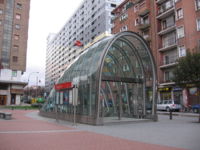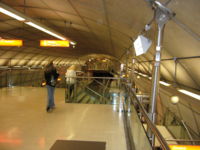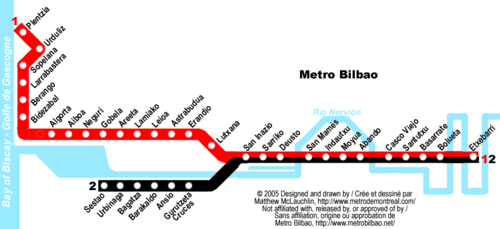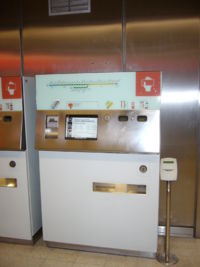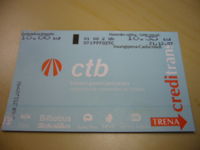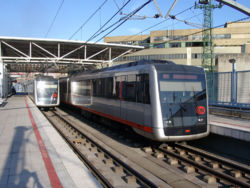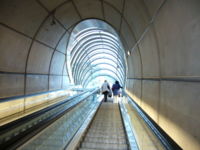Metro Bilbao
| Locale | Bilbao - Greater Bilbao |
|---|---|
| Transit type | Rapid transit |
| Began operation | November 11, 1995 |
| System length | 38 km (23.75 miles) |
| No. of lines | 2 |
| No. of stations | 36 |
| Daily ridership | 214,000 (FY 2006) |
| Track gauge | narrow gauge (metric) |
| Operator | Biscay Transport Consortium (CTB) |
Metro Bilbao is a metro system serving the northern Spanish city of Bilbao and its metropolitan area (Greater Bilbao). It has a metre gauge.
Contents
History
The contract for the underground metro system in Bilbao, Spain was awarded to architects Sir Norman Foster and partners in 1988 following an open competition as metro was decided to be the best method to improve congestion problems in the evolving and regenerating city.
Metro Bilbao is used by more than 78 million people every year. Since it serves about 680,000, each citizen travels about 115 times a year. That is one of the highest rates of usage in Europe.
Line 1
The first part of line one opened on 11 November 1995, with 23 stations between Casco Viejo and Plentzia. The out-of-Bilbao tracks were previously part of Eusko Trenbideak / Ferrocarriles Vascos (EuskoTren) and earlier of FEVE.
By July 5 1997, the total number of stations reached 27 as Santutxu, Basarrate and Bolueta joined Gobela opened the previous year.
Line 2
The first line, operating to the north of the River Nervión was later to be added to with a second line, operating to the south. Splitting from the original line at San Inazio, it currently runs to Portugalete with construction further to the west currently underway. The original five stations (Gurutzeta-Cruces, Ansio, Barakaldo, Bagatza and Urbinaga) were opened on 13 April 2002. The furthest eastern point is now Etxebarri station, opened along with Sestao on 8 January 2005. Line 2 was enlarged with two new stations in Portugalete that were opened in January 20 2007. It competes with the lucrative pre-existing Renfe line from Bilbao to Santurtzi.
Extension plans
Line 2 will reach Santurtzi by 2009 with three new stations and Basauri, at the other extreme of the network, will be served by two new stations by 2010. At this point the original plan for the metro will be complete, the network will have 41 stations and 44.5 km (27.81 miles).
No further plans have been made for the metro, there have been talks about a third line that would serve only the city of Bilbao, from Rekalde to Otxarkoaga in a south to north layout that would serve neighbourhoods that are currently too far from the metro. These plans are currently on political debate, but seem to have been rejected to favour an extension of the EuskoTran network inside the city.
A new airport rail connection is being projected, that would also link the eastern neighbourhoods of Bilbao with the metro, but this line that could be considered as a third metro line is going to be managed by EuskoTren.
Design
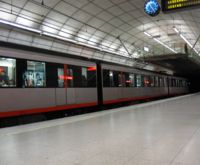
Access to the metro is provided by 'fosteritos', glass structures affectionately named after the architect. These modern-looking tunnels stand attractive alongside the modern and innovative interior of the stations.
Large caverns of a 160m2 cross section were dug for stations, creating large open spaces, as opposed to the traditional sets of linked tunnels. For example the ticket line is in the same space as the trains, for this purpose steel structures called 'mezzanines' have been built over the tracks. Trains are fully accessible by lifts and escalators. Materials such as steel and concrete have been used throughout.
Sarriko station won the 1998 Brunel Award for Railway Design. It is noticeably different from the rest of the stations in the network: in place of the standard 'fosterito', a vast glazed atrium pours natural light into the entire station, and the long, unbroken escalator ride to the ticket hall from street level gives a dramatic sense of character to the station.
Away from the main structures, the design company Akaba created the seating systems for the Metro, which subsequently won the Spanish National Industrial Design Prize from the Ministry of Science and Technology in November 2000. A distinctive signage system was created by Otl Aicher, which are responsible for the eye-catching masts bearing the Metro logo. The principal colours used are of white lettering on a red background for key information and black lettering for secondary details.
Lines
Metro Bilbao consists of the following lines: (see also Metro Bilbao Stations)
| Line | Length | Stations | |
| 1 | 29.4km (18.4 miles) | 28 | |
| 2 | 8.8km (5.5 miles) (*) | 8 (*) | |
(*) Line 2 numbers refer only to the line 2 branch (San Inazio-Portugalete), from Etxebarri to San Inazio Lines 1 and 2 share tracks and stations.
Network Map
Operation
The network is divided into three fare zones:
- Zone A, central Bilbao, from Bolueta to San Inazio.
- Zone B, from San Inazio to Bidezabal (Line 1) and Portugalete (Line 2); Etxebarri station (Lines 1/2).
- Zone C, from Bidezabal to Plentzia (Line 1).
The ticket system is closed, tickets must be validated on entering and exiting the stations. There are single tickets, ten trip tickets and monthly passes with discounts for senior and junior citizens.
The most popular ticket is the Creditrans travelcard, that offers discounts when traveling around Bilbao in the Bilbobus and BizkaiBus buses, the tramway and FEVE trains, among other means of transport in the metropolitan area.
The system works from 6 AM to 11 PM on workdays and Sundays and to 1:30 AM on Fridays. There is an all night service on Saturday nights, with trains every half hour.
Service frequencies during workdays are every 2 minutes in zone A, every 5 minutes in zone B and every 20 minutes in zone C. These frequencies decrease to 5 minutes in zone A and 10 minutes in zone B during off peak hours and Sundays or bank holidays.
Trains
The Metro Bilbao uses presently train types of the series UT-500 and UT-550, built by CAF. The company uses 24 trains of the first series and thirteen of the second. All vehicles are maintained and parked in Urduliz and Ariz.
The first sixteen vehicles which carry the numbers UT 501 to 516 were delivered by CAF and ABB in November 1995. Inside each car 2+2 seats are arranged respectively vis-à-vis in the colors of the Corporate design – red and grey –. A set of four cars is altogether 72.12 meters long, 3.85 meters high and 2.80 meters wide. That's specially wide for a train that uses narrow gauge, for example vehicles of the large profile Berlin metro are only 2.65 meters wide, and they use the European normal gauge of 1435 millimeters.
The trains use, like the commuter railroads in the region, the overhead tension of 1500 volts and possess altogether sixteen motors of respectively 180 kilowatts; together that yields 2880 kilowatts per train unit. The maximum speed is 50 mph (80 km/h). A train can carry 712 persons. This statement is based upon 144 seats and 568 standing on the average six persons per square meter.
The number of trains was increased after a renewed order in 1996 to a total of 24 trains with the numbers UT 517 until 524. For the higher requirement in the newly constructed line 2, thirteen new trains were ordered to the firms CAF and Adtranz (now mother company of ABB) and they were delivered in October 2001. The last delivery contained now the new trains of the series UT-550. This series differs from its predecessor in a higher efficiency, needed to climb the deep line 2 tunnel under the river, and an improved air-conditioning.
Since 1998 the ATP system is used (automatic train protection), as well as ATO (automatic train operation) installed. The latter implies that the train drivers must press solely a button, and the remainder of the train operation is done through the computer. This is to be seen as an initial stage for a system gone completely controlled by the computer
External links
| Wikimedia Commons has media related to: Metro Bilbao |
See also
| Transport in and around Bilbao | |
|---|---|
|
Creditrans | Metro Bilbao | Cercanías Bilbao | EuskoTran | Bilbobus | BizkaiBus | Artxanda Funicular | Vizcaya Bridge | FEVE | EuskoTren | |
de:Metro Bilbao es:Metro Bilbao eu:Bilboko metroa fr:Métro de Bilbao it:Metropolitana di Bilbao
